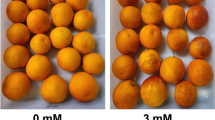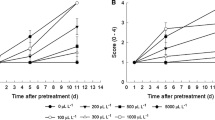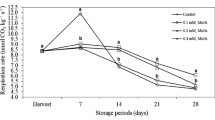Abstract
Methyl jasmonate (MeJA) treatment can significantly increase glucosinolate (GS) concentrations in Brassica vegetables and potentially enhance anticancer bioactivity. Although MeJA treatment may promote ethylene biosynthesis, which can be detrimental to postharvest quality, there are no previous reports of its effect on cauliflower postharvest quality. To address this, cauliflower curds in field plots were sprayed with either 0.1 % Triton X-100 (control) or 500 μM MeJA solutions four days prior to harvest, then stored at 4 °C. Tissue subsamples were collected after 0, 10, 20, and 30 days of postharvest storage and assayed for visual color change, ethylene production, GS concentrations, and extract quinone reductase inductive activity. MeJA treatment increased curd GS concentrations of glucoraphanin, glucobrassicin, and neoglucobrassicin by 1.5, 2.4, and 4.6-fold over controls, respectively. MeJA treated cauliflower showed significantly higher quinone reductase activity, a biomarker for anticancer bioactivity, without reducing visual color and postharvest quality for 10 days at 4 °C storage.




Similar content being viewed by others
References
van Poppel G, Verhoeven DT, Verhagen H, Goldbohm RA (1999) Brassica vegetables and cancer prevention. Epidemiology and mechanisms. Adv Exp Med Biol 472:159–168
Cuendet M, Oteham CP, Moon RC, Pezzuto JM (2006) Quinone reductase induction as a biomarker for cancer chemoprevention. J Nat Prod 69(3):460–463
Kim HS, Juvik JA (2011) Effect of selenium fertilization and methyl jasmonate treatment on glucosinolate accumulation in broccoli florets. J Am Soc Hort Sci 136(4):239–246
Singh G, Kawatra A, Sehgal S (2001) Nutritional composition of selected green leafy vegetables, herbs and carrots. Plant Foods Hum Nutr 56(4):359–364. doi:10.1023/a:1011873119620
Dixon GR (2007) Vegetable Brassicas and related Crucifers. CABI Pub.
Watanabe K, Kamo T, Nishikawa F, Hyodo H (2000) Effect of methyl jasmonate on senescence of broccoli florets. J Japan Soc Hort Sci 69(5):605–610. doi:10.2503/jjshs.69.605
Brown AF, Yousef GG, Jeffery EH, Klein BP, Wallig MA, Kushad MM, Juvik JA (2002) Glucosinolate profiles in broccoli: variation in levels and implications in breeding for cancer chemoprotection. J Am Soc Hortic Sci 127(5):807–813
Prochaska HJ, Santamaria AB (1988) Direct measurement of NAD(P)H:quinone reductase from cells cultured in microtiter wells: a screening assay for anticarcinogenic enzyme inducers. Anal Biochem 169(2):328–336
Fritz VA, Justen VL, Bode AM, Schuster T, Wang M (2010) Glucosinolate enhancement in cabbage induced by jasmonic acid application. Hortscience 45(8):1188–1191
Bodnaryk RP (1994) Potent effect of jasmonates on indole glucosinolates in oilseed rape and mustard. Phytochemistry (Oxford) 35(2):301–305
Zhang Y, Talalay P, Cho CG, Posner GH (1992) A major inducer of anticarcinogenic protective enzymes from broccoli: isolation and elucidation of structure. Proc Natl Acad Sci USA 89(6):2399–2403
Zhu CY, Loft S (2003) Effect of chemopreventive compounds from Brassica vegetables on NAD(P)H:quinone reductase and induction of DNA strand breaks in murine hepa1c1c7 cells. Food Chem Toxicol 41(4):455–462
Neave AS, Sarup SM, Seidelin M, Duus F, Vang O (2005) Characterization of the N-methoxyindole-3-carbinol (NI3C)‚ induced cell cycle arrest in human colon cancer cell lines. Toxicol Sci 83(1):126–135
Bitir B, Erginer M, Engin E, Vang O (2011) Determination combinatory effect of indole 3 carbinol and N-methoxy indole-3-carbinol on cell proliferation in HCT 116 cell line. http://rudar.ruc.dk/handle/1800/6491. Accessed 16 Nov 2012
Haack M, Lowinger M, Lippmann D, Kipp A, Pagnotta E, Iori R, Monien BH, Glatt H, Brauer MN, Wessjohann LA, Brigelius-Flohe R (2010) Breakdown products of neoglucobrassicin inhibit activation of Nrf2 target genes mediated by myrosinase-derived glucoraphanin hydrolysis products. Biol Chem 391(11):1281–1293
Conflict of Interest
The authors declare that they have no conflict of interest. This article does not contain any studies with human or animal subjects.
Author information
Authors and Affiliations
Corresponding author
Additional information
Kang Mo Ku and Jeong-Hee Choi contributed equally to this work.
Rights and permissions
About this article
Cite this article
Ku, K.M., Choi, JH., Kushad, M.M. et al. Pre-harvest Methyl Jasmonate Treatment Enhances Cauliflower Chemoprotective Attributes Without a Loss in Postharvest Quality. Plant Foods Hum Nutr 68, 113–117 (2013). https://doi.org/10.1007/s11130-013-0356-y
Published:
Issue Date:
DOI: https://doi.org/10.1007/s11130-013-0356-y




